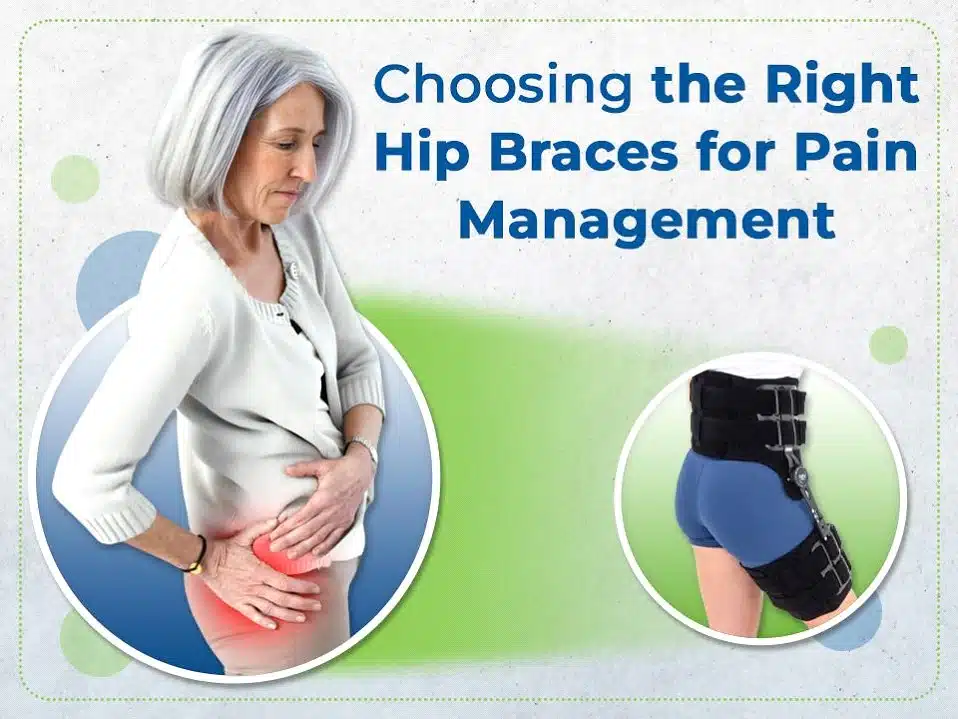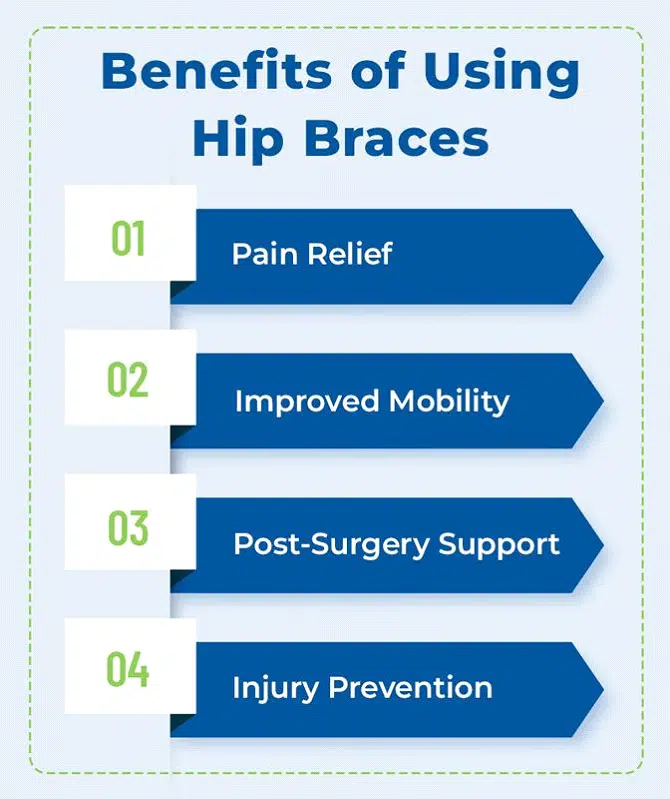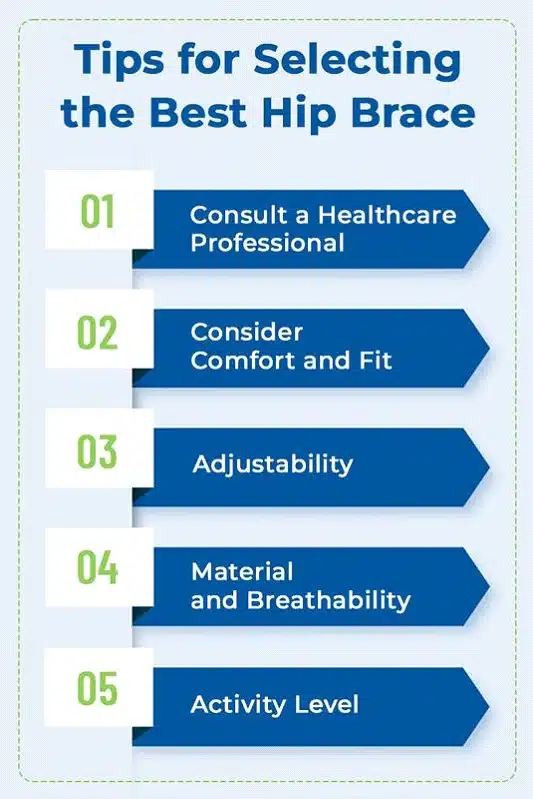Dealing with hip pain can be challenging and disruptive to daily life. Hip braces can play a crucial role in pain management, whether recovering from an injury, managing a chronic condition, or seeking relief from discomfort. In this article, we’ll explore the importance of choosing the right hip brace for effective pain management, discuss various hip support options, and provide valuable tips to help you find the best hip brace tailored to your needs.
Understanding Hip Pain and Its Impact
Hip pain is a common issue that can significantly affect your quality of life. It can result from various causes, including injuries, arthritis, muscle imbalances, or structural problems within the hip joint. The impact of hip pain extends beyond discomfort; it can limit your mobility, disrupt your posture, and make everyday activities challenging.
Finding the right hip brace can be crucial in managing your discomfort and promoting pain relief, whether you’re experiencing hip pain due to a recent injury or a chronic condition like osteoarthritis. Hip braces are designed to provide support, stability, and compression to the affected area, helping you regain mobility and improve your overall well-being.
Types of Hip Braces for Pain Management
When it comes to managing hip pain, various types of hip braces are available, each designed to address specific needs and conditions:
- Compression Hip Sleeves: These are popular for individuals with mild to moderate hip pain. Compression hip sleeves provide gentle yet effective compression to the hip joint and the surrounding muscles. This compression helps improve blood circulation, reduce inflammation, and alleviate discomfort. They are comfortable to wear and can be an excellent option for daily use.
- Hip Wraps and Belts: Hip wraps and belts offer customizable support and compression. They come with adjustable straps or closures, allowing you to tailor the pressure level to your comfort and pain relief needs. These braces are versatile and can be used for various hip conditions, including hip bursitis and tendonitis. They provide the benefit of targeted support where it’s needed most.
- Hip Stabilizers: If you’re dealing with severe hip injuries or recovering from hip surgery, hip stabilizers are the go-to option. These braces offer maximum support and stability to the hip joint. They restrict excessive movement, which can be crucial for aiding the healing process and preventing further injury. Hip stabilizers are often recommended post-surgery to ensure optimal recovery.
- Hip Abduction Braces: Hip abduction braces are specialized devices primarily used after hip replacement surgery or for conditions that require controlled hip abduction. They maintain the correct positioning of the hip joint during recovery, promoting the healing of the surgical site and preventing complications. These braces are essential for a successful recovery process.<Dealing with hip pain can be challenging and disruptive to daily life. Hip braces can play a crucial role in pain management, whether recovering from an injury, managing a chronic condition, or seeking relief from discomfort. In this article, we’ll explore the importance of choosing the right hip brace for effective pain management, discuss various hip support options, and provide valuable tips to help you find the best hip brace tailored to your needs.
Understanding Hip Pain and Its Impact
Hip pain is a common issue that can significantly affect your quality of life. It can result from various causes, including injuries, arthritis, muscle imbalances, or structural problems within the hip joint. The impact of hip pain extends beyond discomfort; it can limit your mobility, disrupt your posture, and make everyday activities challenging.
Finding the right hip brace can be crucial in managing your discomfort and promoting pain relief, whether you’re experiencing hip pain due to a recent injury or a chronic condition like osteoarthritis. Hip braces are designed to provide support, stability, and compression to the affected area, helping you regain mobility and improve your overall well-being.
Types of Hip Braces for Pain Management
When it comes to managing hip pain, various types of hip braces are available, each designed to address specific needs and conditions:
- Compression Hip Sleeves: These are popular for individuals with mild to moderate hip pain. Compression hip sleeves provide gentle yet effective compression to the hip joint and the surrounding muscles. This compression helps improve blood circulation, reduce inflammation, and alleviate discomfort. They are comfortable to wear and can be an excellent option for daily use.
- Hip Wraps and Belts: Hip wraps and belts offer customizable support and compression. They come with adjustable straps or closures, allowing you to tailor the pressure level to your comfort and pain relief needs. These braces are versatile and can be used for various hip conditions, including hip bursitis and tendonitis. They provide the benefit of targeted support where it’s needed most.
- Hip Stabilizers: If you’re dealing with severe hip injuries or recovering from hip surgery, hip stabilizers are the go-to option. These braces offer maximum support and stability to the hip joint. They restrict excessive movement, which can be crucial for aiding the healing process and preventing further injury. Hip stabilizers are often recommended post-surgery to ensure optimal recovery.
- Hip Abduction Braces: Hip abduction braces are specialized devices primarily used after hip replacement surgery or for conditions that require controlled hip abduction. They maintain the correct positioning of the hip joint during recovery, promoting the healing of the surgical site and preventing complications. These braces are essential for a successful recovery process.
Benefits of Using Hip Braces
Hip braces offer a range of benefits for individuals dealing with hip pain and related conditions:
A blue and green sign with white text, promoting pain management through hip braces.
- Pain Relief: Hip braces provide targeted compression and support, effectively reducing pain and discomfort associated with various hip conditions. Stabilizing the joint and surrounding muscles alleviates strain and pressure, promoting relief.
- Improved Mobility: The right hip brace can significantly enhance your mobility. Providing support and reducing pain makes it easier to perform daily activities with fewer limitations. You can regain the freedom to move comfortably and without hesitation.
- Post-Surgery Support: For individuals recovering from hip surgery, hip braces are crucial in ensuring a successful and complication-free recovery. They offer stability and protection to the surgical area, helping you regain strength and mobility at a controlled pace.
- Injury Prevention: Hip braces are not only for pain management but also as preventive tools. Wearing a hip brace can help prevent further injuries or strain if you engage in physical activities or sports. It provides an extra layer of protection for your vulnerable hip joint.
Read More: The Benefits of Using a Hip Support Brace for Pain Relief
Understanding the various types of hip braces and their benefits is essential for effective pain management and overall well-being. Whether you need relief from hip pain, support during recovery, or injury prevention, choosing the right hip brace tailored to your specific needs can significantly improve your comfort and quality of life.
Tips for Selecting the Best Hip Brace
Choosing the right hip brace is crucial for effective pain management and comfort. Here are some valuable tips to help you make an informed decision:
A blue and white sign promoting pain management and hip braces, with white text.
- Consult a Healthcare Professional: Before selecting a hip brace, it’s essential to consult with a healthcare provider or orthopedic specialist. They can assess your specific condition, identify the underlying cause of your hip pain, and provide personalized recommendations for the most suitable hip brace. Their expertise ensures you choose the right type of brace for your unique needs.
- Consider Comfort and Fit: Comfort and fit are paramount in hip braces. A well-fitted brace should provide optimal support without causing discomfort or irritation. It should fit snugly around your hip joint and the surrounding area. Be sure to follow sizing guidelines provided by the manufacturer or your healthcare provider to ensure the correct fit.
- Adjustability: Look for a hip brace with adjustable features like straps or closures. These adjustable components allow you to customize the level of support and compression based on your comfort and pain relief requirements. The ability to fine-tune the fit ensures you get the most benefit from your hip brace.
- Material and Breathability: Consider the material of the hip brace and its breathability. Opt for a brace made from breathable and moisture-wicking fabric. Breathable materials help prevent excessive sweating, reduce skin irritation, and enhance overall comfort, especially if you plan to wear the brace for extended periods.
- Activity Level: Consider your activity level and lifestyle when selecting a hip brace. Some braces are designed for daily wear and provide all-day support, making them suitable for individuals with chronic hip pain. Others are more specialized and intended for specific activities or recovery periods, such as post-surgery braces. Choose a brace that aligns with your daily routine and needs.
By following these tips and seeking professional guidance, you can confidently select the best hip brace to manage your pain, enhance your mobility, and improve your overall well-being. A well-chosen hip brace can significantly improve your comfort and quality of life.
Hip Brace Dos and Don’ts
Hip braces can be valuable tools in managing pain and providing support, but using them correctly is crucial to maximize their benefits. Here are some practical dos and don’ts to keep in mind when using a hip brace:
Dos
- Consult a Healthcare Professional: Consult a healthcare provider or orthopedic specialist before using a hip brace. They can assess your condition, recommend the appropriate type of brace, and provide guidance on its usage.
- Follow the Instructions: Do carefully read and follow the manufacturer’s instructions for your hip brace. Proper usage is essential for effective pain management.
- Wear the Brace as Prescribed: If your healthcare provider recommends specific times to wear the brace, adhere to their instructions. Wearing the brace consistently can help achieve the desired results.
- Ensure Proper Fit: Ensure that your hip brace fits correctly. A well-fitted brace provides optimal support and comfort. If it’s adjustable, make necessary adjustments to achieve the right fit.
- Use Padding if Necessary: If you experience discomfort or skin irritation from the brace, consider using soft padding or a breathable fabric between your skin and the brace for added comfort.
- Gradual Adjustment: If your brace restricts movement, such as after surgery, follow a gradual adjustment plan provided by your healthcare provider. This helps your body adapt to the brace’s limitations over time.
- Combine with Physical Therapy: Consider combining a hip brace with physical therapy exercises or recommended stretches. This can enhance the overall effectiveness of pain management and recovery.
Don’ts
- Don’t Self-Diagnose: Don’t attempt to self-diagnose or self-prescribe a hip brace without professional guidance. Hip pain can have various causes, and the wrong brace may not provide the necessary support.
- Don’t Over-Tighten: Avoid over-tightening the hip brace, which can lead to discomfort, restricted circulation, or skin irritation. Follow the recommended adjustment guidelines.
- Don’t Ignore Discomfort: If you experience increased discomfort, pain, or skin irritation while wearing the brace, discontinue use and consult your healthcare provider. Ignoring discomfort may lead to complications.
- Don’t Use One-Size-Fits-All Solutions: Avoid using a generic or one-size-fits-all hip brace if you have specific needs or conditions. Customization and proper fit are essential for effective pain management.
- Don’t Wear It 24/7: In most cases, it’s not advisable to wear a hip brace 24/7. Follow your healthcare provider’s recommendations regarding when and how long to wear the brace daily.
- Don’t Neglect Hygiene: Regularly clean and maintain your hip brace according to the manufacturer’s instructions. Neglecting hygiene can lead to skin issues or discomfort.
- Don’t Discontinue Abruptly: If your healthcare provider recommends discontinuing the hip brace, do so gradually and as directed. Abruptly stopping its use may result in discomfort or a setback in your recovery.
By following these dos and don’ts, you can ensure that you are using your hip brace effectively and safely. Remember that proper usage, with professional guidance and recommended therapies, can significantly contribute to pain management and overall well-being.
Conclusion
Choosing the right hip brace for pain management is a significant step toward regaining comfort and mobility. By understanding the different types of hip braces, recognizing their benefits, and following essential selection tips, you can find the perfect hip support that aligns with your specific needs. Say goodbye to hip pain-related limitations and hello to a more active and pain-free life with the right hip brace by your side.
Key Phrases
- Hip braces for pain
- Choosing the right brace
- Hip pain management
- Hip support options
- Benefits of hip braces
- Tips for hip brace selection
- Best hip brace for pain
- Hip brace for effective relief
/li>
Benefits of Using Hip Braces
Hip braces offer a range of benefits for individuals dealing with hip pain and related conditions:
- Pain Relief: Hip braces provide targeted compression and support, effectively reducing pain and discomfort associated with various hip conditions. Stabilizing the joint and surrounding muscles alleviates strain and pressure, promoting relief.
- Improved Mobility: The right hip brace can significantly enhance your mobility. Providing support and reducing pain makes it easier to perform daily activities with fewer limitations. You can regain the freedom to move comfortably and without hesitation.
- Post-Surgery Support: For individuals recovering from hip surgery, hip braces are crucial in ensuring a successful and complication-free recovery. They offer stability and protection to the surgical area, helping you regain strength and mobility at a controlled pace.
- Injury Prevention: Hip braces are not only for pain management but also as preventive tools. Wearing a hip brace can help prevent further injuries or strain if you engage in physical activities or sports. It provides an extra layer of protection for your vulnerable hip joint.
Read More: The Benefits of Using a Hip Support Brace for Pain Relief
Understanding the various types of hip braces and their benefits is essential for effective pain management and overall well-being. Whether you need relief from hip pain, support during recovery, or injury prevention, choosing the right hip brace tailored to your specific needs can significantly improve your comfort and quality of life.
Tips for Selecting the Best Hip Brace
Choosing the right hip brace is crucial for effective pain management and comfort. Here are some valuable tips to help you make an informed decision:
- Consult a Healthcare Professional: Before selecting a hip brace, it’s essential to consult with a healthcare provider or orthopedic specialist. They can assess your specific condition, identify the underlying cause of your hip pain, and provide personalized recommendations for the most suitable hip brace. Their expertise ensures you choose the right type of brace for your unique needs.
- Consider Comfort and Fit: Comfort and fit are paramount in hip braces. A well-fitted brace should provide optimal support without causing discomfort or irritation. It should fit snugly around your hip joint and the surrounding area. Be sure to follow sizing guidelines provided by the manufacturer or your healthcare provider to ensure the correct fit.
- Adjustability: Look for a hip brace with adjustable features like straps or closures. These adjustable components allow you to customize the level of support and compression based on your comfort and pain relief requirements. The ability to fine-tune the fit ensures you get the most benefit from your hip brace.
- Material and Breathability: Consider the material of the hip brace and its breathability. Opt for a brace made from breathable and moisture-wicking fabric. Breathable materials help prevent excessive sweating, reduce skin irritation, and enhance overall comfort, especially if you plan to wear the brace for extended periods.
- Activity Level: Consider your activity level and lifestyle when selecting a hip brace. Some braces are designed for daily wear and provide all-day support, making them suitable for individuals with chronic hip pain. Others are more specialized and intended for specific activities or recovery periods, such as post-surgery braces. Choose a brace that aligns with your daily routine and needs.
By following these tips and seeking professional guidance, you can confidently select the best hip brace to manage your pain, enhance your mobility, and improve your overall well-being. A well-chosen hip brace can significantly improve your comfort and quality of life.
Hip Brace Dos and Don’ts
Hip braces can be valuable tools in managing pain and providing support, but using them correctly is crucial to maximize their benefits. Here are some practical dos and don’ts to keep in mind when using a hip brace:
Dos
- Consult a Healthcare Professional: Consult a healthcare provider or orthopedic specialist before using a hip brace. They can assess your condition, recommend the appropriate type of brace, and provide guidance on its usage.
- Follow the Instructions: Do carefully read and follow the manufacturer’s instructions for your hip brace. Proper usage is essential for effective pain management.
- Wear the Brace as Prescribed: If your healthcare provider recommends specific times to wear the brace, adhere to their instructions. Wearing the brace consistently can help achieve the desired results.
- Ensure Proper Fit: Ensure that your hip brace fits correctly. A well-fitted brace provides optimal support and comfort. If it’s adjustable, make necessary adjustments to achieve the right fit.
- Use Padding if Necessary: If you experience discomfort or skin irritation from the brace, consider using soft padding or a breathable fabric between your skin and the brace for added comfort.
- Gradual Adjustment: If your brace restricts movement, such as after surgery, follow a gradual adjustment plan provided by your healthcare provider. This helps your body adapt to the brace’s limitations over time.
- Combine with Physical Therapy: Consider combining a hip brace with physical therapy exercises or recommended stretches. This can enhance the overall effectiveness of pain management and recovery.
Don’ts
- Don’t Self-Diagnose: Don’t attempt to self-diagnose or self-prescribe a hip brace without professional guidance. Hip pain can have various causes, and the wrong brace may not provide the necessary support.
- Don’t Over-Tighten: Avoid over-tightening the hip brace, which can lead to discomfort, restricted circulation, or skin irritation. Follow the recommended adjustment guidelines.
- Don’t Ignore Discomfort: If you experience increased discomfort, pain, or skin irritation while wearing the brace, discontinue use and consult your healthcare provider. Ignoring discomfort may lead to complications.
- Don’t Use One-Size-Fits-All Solutions: Avoid using a generic or one-size-fits-all hip brace if you have specific needs or conditions. Customization and proper fit are essential for effective pain management.
- Don’t Wear It 24/7: In most cases, it’s not advisable to wear a hip brace 24/7. Follow your healthcare provider’s recommendations regarding when and how long to wear the brace daily.
- Don’t Neglect Hygiene: Regularly clean and maintain your hip brace according to the manufacturer’s instructions. Neglecting hygiene can lead to skin issues or discomfort.
- Don’t Discontinue Abruptly: If your healthcare provider recommends discontinuing the hip brace, do so gradually and as directed. Abruptly stopping its use may result in discomfort or a setback in your recovery.
By following these dos and don’ts, you can ensure that you are using your hip brace effectively and safely. Remember that proper usage, with professional guidance and recommended therapies, can significantly contribute to pain management and overall well-being.
Conclusion
Choosing the right hip brace for pain management is a significant step toward regaining comfort and mobility. By understanding the different types of hip braces, recognizing their benefits, and following essential selection tips, you can find the perfect hip support that aligns with your specific needs. Say goodbye to hip pain-related limitations and hello to a more active and pain-free life with the right hip brace by your side.
Key Phrases
- Hip braces for pain
- Choosing the right brace
- Hip pain management
- Hip support options
- Benefits of hip braces
- Tips for hip brace selection
- Best hip brace for pain
- Hip brace for effective relief









